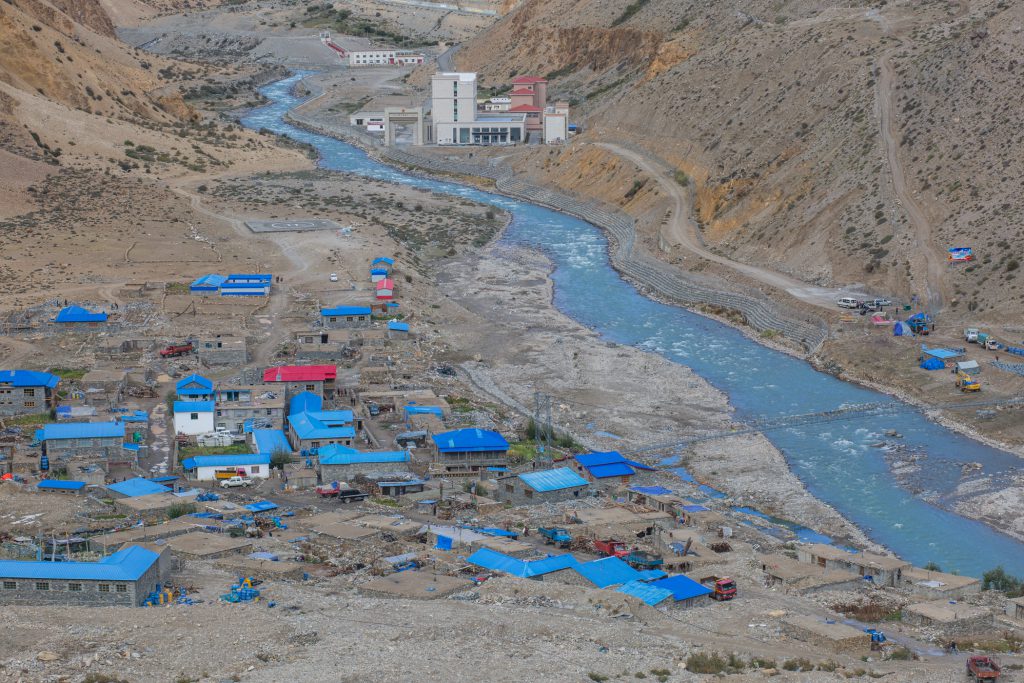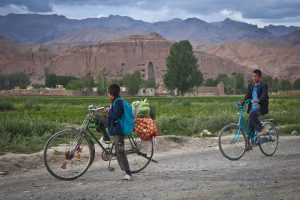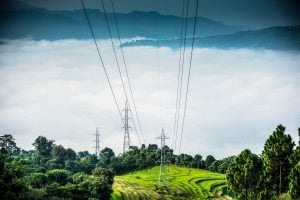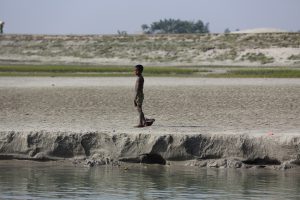This is the first in a five part series on the Karnali River. Read an overview of the whole trip here.
Preparing soup for her grandson under a dim solar powered bulb, 50-year-old Pema Angmo explained how frightening life is on the bank of Karnali River in western Nepal’s Hilsa village, on the border of Tibet. Large embankments protect the huge immigration office and villages in Tibet, but Nepalis on the other bank are left without any protection from floods in place.
“I tell my relatives in Tibet that the gabion walls (as the embankments are known) protect you, but the gods protect us Nepalis,” she smiled. About two decades ago, she started the first hotel on the flood plains of the Karnali River, which originates about 80 kilometres northwest in Tibet. Now there are dozens of hotels. This small town is the last stop in Nepal for people visiting Mount Kailash in the Ngari province of southwestern Tibet.


Born in Tibet, Pema fell in love with a Nepali from Hepka village in Humla and they married about 30 years ago. As years passed, Tibet saw unprecedented development, but Nepal has remained the same. Blacktopped roads built in Tibet over the last decade have made road travel much easier there. Many pilgrims—mostly from India who in the past had to fly to Lhasa in the east and then drive west for hundreds of miles to reach Kailash—started flocking to Hilsa on small planes and helicopters from Nepalgunj in southern Nepal.
Mount Kailash is holy for Hindus who believe God Shiva once meditated there. According to the immigration office in Nepal, about 15,000 tourists go to Kailash via this route every year — equivalent to a quarter of the total population in Humla district.
The sound of helicopters wake us up every morning as they land and take off every few minutes near Pema’s hotel. Only helicopters can land at this busy airport. While business is getting better, people are worried about how to protect their hard earned property from the floods and disasters that may come in future. “It took two decades to build these two buildings, but it won’t take a minute to destroy them if there is a big flood or a dam bursts upstream,” Pema added.
Darkness in Nepal
The Chinese have built a hydropower dam a few kilometres upstream. This has improved the lives of Tibetans by bringing electricity, but increased fear among the Nepalis living next to the border. “They have built strong embankments on their side, but we have nothing. If the dam bursts we will be swept away,” Pema said.
There is hardly any communication between local people and the Chinese authorities. “It’s terribly hard to talk to the authorities, as they don’t listen to us. We face serious problems,” said Amar Lama, another hotelier in the town, unfortunately, “the leaders in our capital have turned a deaf ear to the problems.”
At first, the villagers in Nepal heard they would also be provided electricity. But later the local authorities in Tibet said they would need to wait for a formal agreement between China and Nepal.
Over the last several years, locals in Hilsa have welcomed the Prime Minister and other leaders and pleaded for electricity. Two years ago the then Prime Minister of Nepal, Pushpa Kamal Dahal, inaugurated a bridge that linked Nepal and Tibet and promised to send a team of experts to start work on a hydropower project in Nepal on a tributary of the Karnali River at a cost of NPR 30 million (USD 265,090). Two years later, there is no sign of any work starting. “Prime ministers and ministers fly here, make promises and go to Kailash with their family. Once they fly back, they forget everything. They have amnesia. I am really angry, you know, please tell them if you meet them,” Pema Angmo continued as we were preparing to film her.
Out of 77 districts of Nepal, Humla is the only district not connected to the national road network. It also lacks electricity and a mobile network. “To go to Nepal’s capital it takes weeks if we walk, costs hundreds of dollars if we fly. Who listens to us?” she said, her frustration spilling over.

“We are talking with the Chinese to link the northern border in Hilsa to southern Nepal via a railway network,” Shahi said. “We have had a few rounds of bilateral talks in past few months.” Dreams of railways are deeply etched into the psyche of leaders, but the sad reality is that less than 100 kilometres of road connecting Hilsa to the district headquarter of Simikot, which started in late 1990s, has not been completed.
Disasters loom
As the river levels peak in the summer it poses serious landslide threats. “We are trapped but we can’t leave this place as we make our living from these hotels,” Pema added.
Her hotel started with a couple of tents three decades ago. Now she has three buildings with about 50 rooms. “This is the only property we have and it’s our future but it’s at risk,” reiterated Pema.
In 2012 a landslide killed four people in a single family, including a mother and children, just a few hundred metres away from her hotel. She remembers that dark day. “It still shakes my heart. It looks beautiful now, but the mountains are hard to live in.”

The high losses from landslides are partly the result of the terrain and climate, he wrote in his blog recently, “but they are also largely due to poor land use, planning and construction practices. Nepal is blessed with good levels of expertise in landslides management…but it lacks political will to solve the problem.”
Apart from floods and landslides, studies warn that a mega earthquake is looming in Nepal’s western region after a big quake in central region in 2015 killed more than 10,000 people. It’s been more than 300 years since the last mega earthquake struck western Nepal. “Seismologists say there are two dangers lurking beneath the Himalaya: one is the unfinished business of 2015, and the other is a looming mega quake in western Nepal,” a report in the Nepali Times stated a few months ago.
Rivers run dirty
People in Hilsa used to drink water from the Karnali in the past but with the development boom in Burang 30 kilometres upstream, this is no longer. “We don’t drink water from the river nowadays, it’s polluted by sewage disposed in the rivers upstream,” Pema said. The locals bring water from a nearby spring into their homes through pipes.
![Naumule spring, the only source of drinking water for the people in Hilsa, Nepal [image by: Nabin Baral]](https://dialogue.earth/content/uploads/2019/01/photos-for-story-one-7-1024x683.jpg)
Still shrouded in darkness, with no road connection or mobile network, the locals in the border town of Hilsa face more challenges as development upstream gathers pace. And both the Chinese and Nepali governments ignore the problems facing downstream people.
![A boy with Kerosene lamp in his house in Tumkot village, Humla district of Nepal [image by: Nabin Baral]](https://dialogue.earth/content/uploads/2019/01/photos-for-story-one-10-1024x683.jpg)
![<p>Rakchaas Taal (Demon Lake) south of Kailash. Many Nepalese believe it is the source of the Karnali, but scientists dispute this [image by: Nabin Baral]</p>](https://dialogue.earth/content/uploads/2019/01/photos-for-story-one-3.jpg)





![Kagbeni is a small village located in the Kali-Gandaki Valley. The Gandaki River originates in the Himalayas and flows through [image by: Justin Falcone]](https://dialogue.earth/content/uploads/2019/01/Mustang1-300x200.jpeg)

